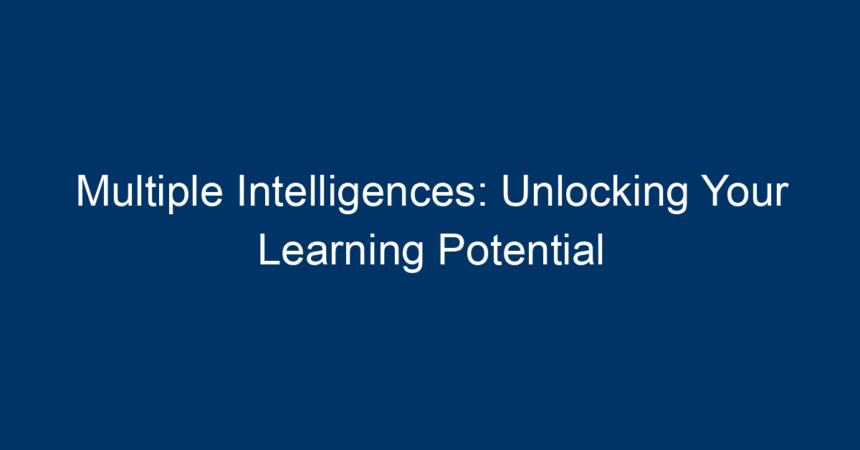In a world where traditional education often emphasizes rote memorization and standardized testing, the theory of multiple intelligences offers a refreshing perspective on how we learn. Developed by psychologist Howard Gardner in 1983, this concept revolutionizes our understanding of intelligence by proposing that individuals possess various types of intelligences. Recognizing these varying abilities can unlock your learning potential and tailor educational experiences to fit your unique profile.
In this article, we’ll explore the spectrum of multiple intelligences, how they can affect your learning, and actionable strategies to leverage them for personal and academic growth.
Understanding Multiple Intelligences
At the core of Gardner’s theory are eight distinct types of intelligence, each representing a different way people process information and learn. Let’s delve into these various types of intelligences:
-
Linguistic Intelligence
- Often associated with poets, writers, and speakers, linguistic intelligence refers to the ability to use language effectively. People with high linguistic intelligence often excel in reading, writing, and verbal communication.
-
Logical-Mathematical Intelligence
- This intelligence involves the capacity for logical reasoning and problem-solving. Mathematicians, scientists, and statisticians are prime examples of individuals who exemplify this intelligence.
-
Spatial Intelligence
- Spatial intelligence relates to how we visualize and manipulate objects in a space. Architects, artists, and engineers often possess strong spatial intelligence, allowing them to create intricate designs and visions.
-
Musical Intelligence
- Individuals with musical intelligence have a profound understanding of rhythm, tone, and sound. Musicians and composers are typically gifted in this area, able to perceive and create music with great precision.
-
Bodily-Kinesthetic Intelligence
- This form of intelligence is reflected in physical prowess. Dancers, athletes, and surgeons exemplify bodily-kinesthetic intelligence, which encompasses control over body movements and manual dexterity.
-
Interpersonal Intelligence
- Interpersonal intelligence is the ability to understand and interact effectively with others. Professionals like teachers, therapists, and leaders excel in this area, as they are keenly aware of others’ emotions and motivations.
-
Intrapersonal Intelligence
- This intelligence pertains to self-awareness and the capacity for introspection. Individuals with strong intrapersonal intelligence understand their own feelings, motivations, and strengths.
- Naturalistic Intelligence
- Naturalistic intelligence involves sensitivity to the natural world. Biologists, environmentalists, and farmers typically excel in this area, recognizing patterns and relationships in nature.
Why It Matters: The Importance of Acknowledging Multiple Intelligences
Understanding multiple intelligences is crucial for enhancing educational practices and personal learning experiences. Here are several reasons why it matters:
1. Personalized Learning
Recognizing the different types of intelligence allows for tailored educational approaches. When learning methods align with an individual’s strengths, motivation and engagement increase significantly. This personalization transforms doubts into confidence.
2. Enhanced Problem-Solving
With multiple intelligences in play, learners can leverage their unique strengths when approaching problems. For example, a person with strong logical-mathematical intelligence may approach challenges analytically, while someone with spatial intelligence might visualize solutions creatively.
3. Improved Collaboration
In group settings, understanding that team members have diverse intelligences can enhance collaboration and teamwork. By capitalizing on each member’s strengths, teams can become more effective and cohesive.
Implementing Multiple Intelligences in Learning
Now that we’ve grasped the theory behind multiple intelligences, let’s explore practical ways to implement this understanding into your learning environment.
1. Assess Your Intelligence Profile
Begin your journey by assessing which intelligences dominate your profile. Various online inventories and quizzes can assist in identifying your strengths and weaknesses. This self-awareness is the first step towards customizing your personal learning strategies.
2. Diversify Learning Materials
Once you understand your preferred intelligences, seek out diverse learning materials that cater to them. This might include:
- Books and Articles (Linguistic)
- Mathematical Puzzles (Logical-Mathematical)
- Visual Aids (Spatial)
- Music and Rhythm Exercises (Musical)
- Hands-on Activities (Bodily-Kinesthetic)
- Group Discussions (Interpersonal)
- Journaling (Intrapersonal)
- Nature Walks (Naturalistic)
3. Incorporate Varied Learning Techniques
Adopt various study techniques that resonate with your intelligence types. For example:
- Mind Mapping for spatial intelligence
- Storytelling for linguistic learners
- Role-playing for interpersonal enthusiasts
4. Foster Collaborative Learning
Engage in group projects or study sessions where you can learn from others with different intelligences. This would help reinforce your understanding while also appreciating diverse perspectives.
5. Set SMART Goals
Setting SMART (Specific, Measurable, Achievable, Relevant, Time-bound) goals can help you focus on areas you wish to develop. For instance, if you aim to improve your musical intelligence, you could set a goal to learn a new instrument over three months.
6. Reflect on Your Learning Journey
At the end of each learning module or experience, take time to reflect. What strategies were most effective? In what areas did you struggle? Reflection fuels growth and helps you adapt your approach.
Conclusion: Embrace Your Unique Learning Style
The concept of multiple intelligences opens a world of possibilities for enhancing your learning experience. By identifying your unique strengths and understanding how to leverage them, you can unlock your full potential. This approach not only fosters personal growth and development but also cultivates a more inclusive and effective learning environment.
By embracing the diversity of intelligence, you empower yourself and others to learn in ways that resonate deeply. Whether through storytelling, problem-solving, or visual representation, the path to mastery is uniquely yours. As you continue this journey, remember to celebrate your successes, no matter how small, and stay curious about the vast world of knowledge waiting to be explored.
Actionable Insights
- Take an online assessment to identify your dominant intelligences.
- Experiment with diverse learning techniques that align with your strengths.
- Form study groups that appreciate and embrace multiple intelligences.
- Continuously reflect and adjust your learning strategies for ongoing growth.
Feel empowered to explore your unique learning style, and unlock your endless potential through the lens of multiple intelligences!




